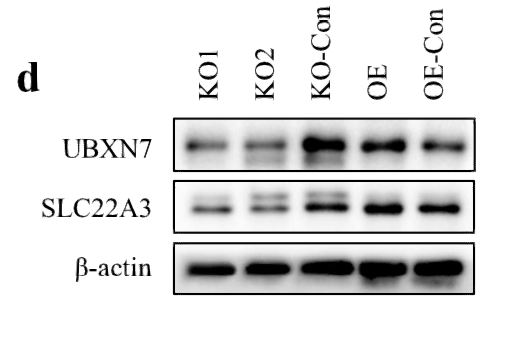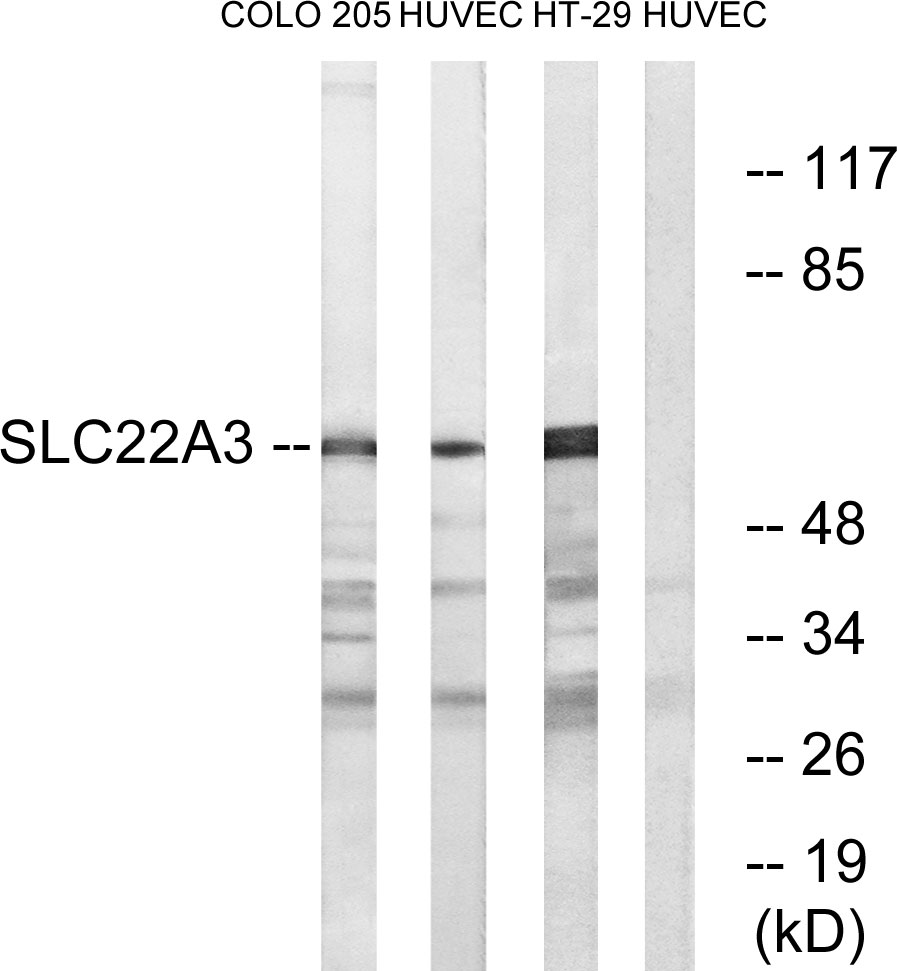OCT3 Polyclonal Antibody
- Catalog No.:YT3232
- Applications:WB;ELISA
- Reactivity:Human;Rat;Mouse;
- Target:
- OCT3
- Fields:
- >>Choline metabolism in cancer
- Gene Name:
- SLC22A3
- Protein Name:
- Solute carrier family 22 member 3
- Human Gene Id:
- 6581
- Human Swiss Prot No:
- O75751
- Mouse Swiss Prot No:
- Q9WTW5
- Immunogen:
- The antiserum was produced against synthesized peptide derived from human SLC22A3. AA range:275-324
- Specificity:
- OCT3 Polyclonal Antibody detects endogenous levels of 40819 protein.
- Formulation:
- Liquid in PBS containing 50% glycerol, 0.5% BSA and 0.02% sodium azide.
- Source:
- Polyclonal, Rabbit,IgG
- Dilution:
- WB 1:500 - 1:2000. ELISA: 1:10000. Not yet tested in other applications.
- Purification:
- The antibody was affinity-purified from rabbit antiserum by affinity-chromatography using epitope-specific immunogen.
- Concentration:
- 1 mg/ml
- Storage Stability:
- -15°C to -25°C/1 year(Do not lower than -25°C)
- Other Name:
- SLC22A3;EMTH;OCT3;Solute carrier family 22 member 3;Extraneuronal monoamine transporter;EMT;Organic cation transporter 3
- Observed Band(KD):
- 61kD
- Background:
- Polyspecific organic cation transporters in the liver, kidney, intestine, and other organs are critical for elimination of many endogenous small organic cations as well as a wide array of drugs and environmental toxins. This gene is one of three similar cation transporter genes located in a cluster on chromosome 6. The encoded protein contains twelve putative transmembrane domains and is a plasma integral membrane protein. [provided by RefSeq, Jul 2008],
- Function:
- function:Mediates potential-dependent transport of a variety of organic cations. May play a significant role in the disposition of cationic neurotoxins and neurotransmitters in the brain.,similarity:Belongs to the major facilitator superfamily. Organic cation transporter family.,tissue specificity:Expressed in placenta, skeletal muscle, prostate, aorta, liver, fetal lung, salivary gland, adrenal gland, kidney and brain cortex. No expression detected in spleen.,
- Subcellular Location:
- Membrane; Multi-pass membrane protein.
- Expression:
- Expressed in placenta, skeletal muscle, prostate, aorta, liver, fetal lung, salivary gland, adrenal gland, kidney and brain cortex. No expression detected in spleen.
Single cell derived spheres of umbilical cord mesenchymal stem cells enhance cell stemness properties, survival ability and therapeutic potential on liver failure. BIOMATERIALS 2019 Oct 21 WB Human Umbilical cord mesenchymal stem cells (UCMSCs)
CPSF3 Promotes Pre-mRNA Splicing and Prevents CircRNA Cyclization in Hepatocellular Carcinoma. Cancers Qubo Zhu WB Human 1:1000 HepG2 cell,HuH7 cell
- June 19-2018
- WESTERN IMMUNOBLOTTING PROTOCOL
- June 19-2018
- IMMUNOHISTOCHEMISTRY-PARAFFIN PROTOCOL
- June 19-2018
- IMMUNOFLUORESCENCE PROTOCOL
- September 08-2020
- FLOW-CYTOMEYRT-PROTOCOL
- May 20-2022
- Cell-Based ELISA│解您多样本WB检测之困扰
- July 13-2018
- CELL-BASED-ELISA-PROTOCOL-FOR-ACETYL-PROTEIN
- July 13-2018
- CELL-BASED-ELISA-PROTOCOL-FOR-PHOSPHO-PROTEIN
- July 13-2018
- Antibody-FAQs
- Products Images

- CPSF3 Promotes Pre-mRNA Splicing and Prevents CircRNA Cyclization in Hepatocellular Carcinoma. Cancers Qubo Zhu WB Human 1:1000 HepG2 cell,HuH7 cell

- Western Blot analysis of various cells using OCT3 Polyclonal Antibody

- Western blot analysis of lysates from HUVEC, COLO, and HT-29 cells, using SLC22A3 Antibody. The lane on the right is blocked with the synthesized peptide.



